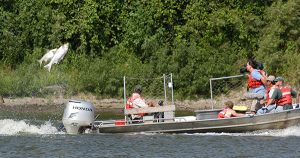June 16, 2021

Assistant professor Binbin Wang
A Mizzou Engineer is helping develop new river turbulence modeling capabilities in hopes of determining potential spawning locations for invasive carp. Assistant Professor Binbin Wang in civil and environmental engineering (CEE) is teaming up with the U.S. Geological Survey’s Columbia Environmental Research Center (CERC) on the project.
“We want to be able to control these fish,” said Duane Chapman, supervisory research fish biologist with CERC. “We have previously partnered with physical scientists that are good at modeling fish-egg transport. That’s important because these carp spawn in rivers only. We’re hoping Dr. Wang’s new model will improve our ability to forecast where carp can live and improve our ability to perhaps make structures that will cause mortality of carp eggs when they spawn.”
These carp have been damaging Missouri river ecosystems for years, according to Chapman, an internationally recognized expert regarding invasive carp. Crappie, large-mouth bass, crayfish and other native aquatic wildlife and plants are hurt by these carp.
In addition, silver carp, one of the four types of invasive carp, can jump out of the water and hit people in their boats. This can cause injuries and property damage. This in turn leads to potentially less tourism and economic activity at riverside recreational areas and fisheries.
“This is an excellent opportunity to have a big impact,” Wang said. “My research is about physics of environmental flows and their interactions with different ‘particles’, like carp eggs. Looking for applications like this is a great example to show how my research can impact society. It’s a very good opportunity to collaborate with the experts in the field at the USGS and CERC.”
Presently, invasive carp are found in the entire lengths of the Mississippi and Missouri rivers within the state. They are also up to the Bagnell Dam along the Osage River in central Missouri, among other rivers.
New Turbulence Modeling of Invasive Carp Spawning Areas

Silver carp jumping out of the water can potentially harm people on boats.
Silver carp jumping out of the water can potentially harm people on boats.
Wang’s physics-based turbulence modeling tools will be developed to eventually find potential invasive carp spawning areas in rivers. This will allow the USGS and other agencies to focus resources to better control the invasive carp population. This new high-resolution model will be useful for all four invasive carp species.
Current models do not compute 3-dimensional processes in habitat availability and sensitivity to hydrology. Although two-dimensional modeling provides useful information, those models do not always work for large turbulent rivers like the Mississippi River. Water can flow over structures within the river, like a groyne or wing dike, along with bedrock. These natural and artificial structures can provide locations for carp to spawn that current modeling does not capture.
“The major advance (for this model) is at that we are looking at a three-dimensional structure,” Wang said. “River flows are highly three dimensional and not homogeneous. Right now, the vertical variations of velocity and turbulence are over-simplified in model prediction, and the new models to be developed will include them to predict carp eggs and larvae.”
This research plans to include a graduate student whose interests are in eco-hydraulics and water resources engineering. The project will also provide training opportunities for undergraduate students in data acquisition, data visualization and scientific presentation. The students will be able to engage with USGS scientists and use groundbreaking experimental modeling tools while applying these tools to large-river management.
Wang’s research interests are in the broad area of environmental flows, using both experimental and modeling approaches to understand the physical processes in the flow and their interaction with chemical and biological processes. He has been with Mizzou Engineering since 2018.
Research Funding
The Missouri Water Resources Research Center (MoWRRC) housed within CEE, along with Wang and CERC, had applied for and was awarded a grant from the USGS totaling $200,535 for this project.
“This (grant) is from a very competitive national program on water resources research. I am very pleased Binbin’s proposal was successful,” Baolin Deng, director of MoWRRC, said. “The project illustrates how fundamental science could help address water and environmental challenges that we are facing.”
Learn more in additional coverage from Show Me News.